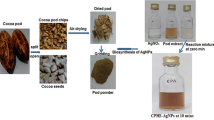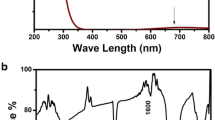Abstract
This study reveals a green process for the production of multi-morphological silver (Ag NPs) and gold (Au NPs) nanoparticles, synthesized using an agro-industrial residue cashew nut shell liquid. Aqueous solutions of Ag+ ions for silver and chloroaurate ions for gold were treated with cashew nut shell extract for the formation of Ag and Au NPs. The nano metallic dispersions were characterized by measuring the surface plasmon absorbance at 440 and 546 nm for Ag and Au NPs. Transmission electron microscopy showed the formation of nanoparticles in the range of 5–20 nm for silver and gold with assorted morphologies such as round, triangular, spherical and irregular. Scanning electron microscopy with energy dispersive spectroscopy and X-ray diffraction analyses of the freeze-dried powder confirmed the formation of metallic Ag and Au NPs in crystalline form. Further analysis by Fourier transform infrared spectroscopy provided evidence for the presence of various biomolecules, which might be responsible for the reduction of silver and gold ions. The obtained Ag and Au NPs had significant antibacterial activity, minimum inhibitory concentration and minimum bactericidal concentration on bacteria associated with fish diseases.







Similar content being viewed by others
References
Mitchell JD, Mori SA (1987) The cashew and its relatives (Anacardium: Anacardiaceae). Mem N Y Bot Gard 42:1–76
Santos ML, Magalhães GC (1999) Utilization of cashew nut shell liquid from Anacardium Occidentale as starting material for organic synthesis: a novel route to lasiodiplodin from cardols. J Braz Chem Soc 10:13–20
John HPT, Naina V (1997) Synthesis of saturated anacardic acids, and alkenyl and alkynyl analogues. J Chem Res (S) 9:14–15
Brust M, Kiely CJ (2002) Some recent advances in nanostructure preparation from gold and silver particles: a short topical review. Colloids Surf A Physicochem Eng Asp 202:175–186
Bankar A, Joshi B, Kumar AR, Zinjarde S (2010) Banana peel extract mediated synthesis of gold nanoparticles. Colloids Surf B: Biointerfaces 80:45–50
Mohanpuria P, Rana NK, Yadav SK (2008) Biosynthesis of nanoparticles: technological concepts and future applications. J Nanopart Res 10:507–517
Kumar V, Yadav SK (2009) Plant-mediated synthesis of silver and gold nanoparticles and their applications. J Chem Technol Biotechnol 84:151–157
Kora AJ, Sashidhar RB, Arunachalam J (2010) Gum kondagogu (Cochlospermum gossypium): a template for the green synthesis and stabilization of silver nanoparticles with antibacterial application. J Carbohydr Polym 82:670–679
Krishnaraj C, Jagan EG, Rajasekar S, Selvakumar P, Kalaichelvan PT, Mohan N (2010) Synthesis of silver nanoparticles using Acalypha indica leaf extracts and its antibacterial activity against water borne pathogens. Colloid Surf B 76:50–56
Wiegand I, Hilpert K, Hancock RE (2008) Agar and broth dilution methods to determine the minimal inhibitory concentration (MIC) of antimicrobial substances. Nat Protoc 3:163–175
Vellora V, Padil T, Cerník M (2013) Green synthesis of copper oxide nanoparticles using gum karaya as a biotemplate and their antibacterial application. Int J Nanomed 8:889–898
Dubey SP, Lahtinen M, Sillanpaa M (2010) Green synthesis and characterizations of silver and gold nanoparticles using leaf extract of Rosa rugosa. Colloids Surf A Physicochem Eng Asp 364:34–41
Badri Narayanan K, Sakthivel N (2008) Coriander leaf mediated biosynthesis of gold nanoparticles. Mater Lett 62:4588–4590
Shahverdi AR, Minaeian S, Shahverdi HR, Jamalifar H, Nohi AA (2007) Rapid synthesis of silver nanoparticles using culture supernatants of Enterobacteria: a novel biological approach. Process Biochem 42:919–923
Song JY, Kim BS (2008) Biological synthesis of bimetallic Au/Ag nanoparticles using persimmon (Diopyros kaki) leaf extract. Korean J Chem Eng 25:808–811
Twu YK, Chen YW, Shih CM (2008) Preparation of silver nanoparticles using chitosan suspensions. Powder Technol 185:251–257
Shankar SS, Rai A, Ahmad A, Sastry M (2004) Rapid synthesis of Au, Ag and bimetallic Au core-Ag shell nanoparticles using neem (Azadirachta indica) leaf broth. J Colloid Interface Sci 275:496–502
Kalishwaralal K, Deepak V, Ram Kumar Pandian SB, Kottaisamy M, BarathmaniKanth S, Kartikeyan B, Gurunathan S (2010) Biosynthesis of silver and gold nanoparticles using Brevibacterium casei. Colloids Surf B Biointerfaces 77:257–262
Paramashivappa R, Kumar PP, Vithayathil PJ, Rao AS (2001) Novel method for isolation of all major phenolic constituents from cashew (Anacardium occidentale L.) nut shell liquid. J Agric Food Chem 49:2548–2551
Philip D (2008) Synthesis and spectroscopic characterization of gold nanoparticles. Spectrochim Acta A Mol Biomol Spectrosc 71:80–85
Liang X, Sun M, Li L, Qiao R, Chen K, Xiao Q, Xu F (2012) Preparation and antibacterial activities of polyaniline/Cu0.05 Zn0.95 O nanocomposites. Dalton Trans 41:2804–2811
Singh M, Kumar P, Patel SKS (2013) Production of polyhy-droxyalkanoate co-polymer by Bacillus thuringiensis. Indian J Microbiol 53:77–83
Das BK, Samal SK, Samantaray BR, Sethi S, Pattnaik P, Mishra BK (2006) Antagonistic activity of cellular components of Pseudomonas species against Aeromonas hydrophila. Aquaculture 253:17–24
Mahanty A, Mishra S, Bosu R, Maurya UK, Netam SP, Sarkar B (2013) Phytoextracts-synthesized silver nanoparticles inhibit bacterial fish pathogen Aeromonas hydrophila. Indian J Microbiol 53:438–446
Odeyemi OA, Asmat A, Usup G (2012) Antibiotics resistance and putative virulence factors of Aeromonas hydrophila isolated from estuary. J Microbiol Biotechnol Food Sci 1:1339–1357
Acknowledgments
This research was supported by Korean National Research Foundation (Korean Ministry of Education, Science and Technology, Award NRF-2011-35B-D00020).
Author information
Authors and Affiliations
Corresponding author
Additional information
Palanivel Velmurugan and Mahudunan Iydroose made equal contributions to this work.
Rights and permissions
About this article
Cite this article
Velmurugan, P., Iydroose, M., Lee, SM. et al. Synthesis of Silver and Gold Nanoparticles Using Cashew Nut Shell Liquid and Its Antibacterial Activity Against Fish Pathogens. Indian J Microbiol 54, 196–202 (2014). https://doi.org/10.1007/s12088-013-0437-5
Received:
Accepted:
Published:
Issue Date:
DOI: https://doi.org/10.1007/s12088-013-0437-5




